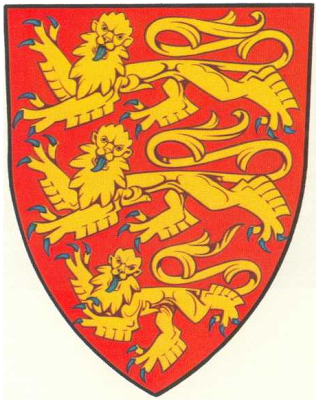
Richard was born in 1157 CE as the second second son of Henry II, king of Angevin.
The Angevin kingdom had started out as Anjou and expanded to include Touraine.
By marriages and inheritance Henry II quite suddenly acquired Aquitaine, Brittany, Normandy and England,
gaining a large and powerful kingdom and instantly becoming a rival of several other kingdoms, most of all France.
Henry II was an energetic and warlike king who was almost constantly on campaign to secure his hold on his lands or to expand them.
In the meanwhile his sons, 'Young' Henry, Richard, Geoffrey and John Lackland, were raised mostly by their mother Eleanor of Aquitaine.
From her Richard inherited the dukedom of Aquitaine, becoming duke in 1172 CE, 14 years old.
Henry's sons all wanted lands of their own, yet Henry was unwilling to relinguish power.
The result was an unprecedented rebellion of his own family, including sons and mother.
Henry proved the strongest and subdued them one by one, Richard holding out the longest.
In 1174 CE the family made peace, but the underlying problems had not been resolved; Eleanor was held prisoner by her own husband.
During the 15 years afterwards father and sons meandered between working together and fighting each other.
When united, they spent their time subduing rebel nobles, who wanted greater autonomy.
During this period Richard learned a lot about warfare in general and especially sieges.
He proved to be the most capable son, taking after his father: energetic and aggressive.
His most notable feat in these years was the capture of the castle of Taillebourg, which was deemed impregnable, though fell after only three days.
But rival rulers like king Philip II of France and count Raymond of Toulouse exploited the strife in the family to their own advantage.
The gap between Richard and his father widened every year.
When Henry II died in 1189 CE, Richard did not shed a single tear.
He spent two years organizing his lands and making sure they would not fell apart in his absence, because he had been planning on going to the Holy Land.
In 1191 CE he started the Third Crusade, together with his rival Philip, who was the junior partner in the enterprise.
Richard took his time traveling, sightseeing in Italy, overwintering in Sicily and even capturing Messina, settling family matters and marrying Berengeria of Navarre.
When she was captured by the rogue Byzantine Isaac of Cyprus, he counterattacked and even conquered the whole island,
which he later sold to the Templars.
Though he was criticized for tarrying, with hindsight this was a strategic masterpiece
that provided the crusaders with a base from which they could supply and reinforce their lands in the Outremer.
Richard arrived in the Outremer in June 1191 CE.
He joined Philip and other christian forces in the siege of Acre and by virtue of the size of his army became a dominant factor.
Despite a valiant defense, the city fell after a few weeks.
Philip, weakened by disease and knowing that important business awaited him in France, sailed back home.
Richard became the supreme commander of the crusader army and led it southwards towards Jaffa.
The muslim forces under Saladin harried the advance, but Richard maintained a superb discipline and forced Saladin into a desperate attack at the Battle of Arsuf,
where the Frankish counterattack inflicted a heavy defeat on the muslims.
After Arsuf the crusaders reinforced Jaffa and over the course of two years made two advances towards Jerusalem.
Both were aborted because Richard realized he had very little chance of taking the city and even less holding it.
Instead he fought a few battles and skirmishes, in which he gained fame for his prowess and bravery, though achieved little.
But developments at home called for his return and so he settled for a three-year truce with Saladin, which allowed christians and merchants access to Jerusalem again.
In 1192 CE he set sail from the Outremer.
All ways home were paved with enemies and bad weather.
The Angevin king tried to evade them via a route through Germany, but was captured by count Leopold, who had been offended at the siege of Acre.
Richard ended up in custody of the German emperor Henry VI.
It took more than a year, 100,000 marks (raised by grumbling peasants) and the promise of the services of an army to get free.
Upon his return his pre-crusade arrangements proved to have held the Angevin kingdom together,
but in the year of captivity Philip had nibbled off significant border territories,
while his rebellious brother John had achieved nothing.
Richard immediately set out recovering castles, towns and lands that had been taken by Philip.
He also built Château Gaillard on the Seine, making it a blueprint for castles in the 13th century CE.
He was well underway of completing the reconquest, when in 1199 CE he was hit by a crossbow bolt during the siege of Chalus-Chabrol.
The wound caught gangrene and he died soon afterwards.
He was succeeded by his brother John, who managed to lose the kingdom in a few years.
The Angevin kingdom was not a cultural unity and without the reputation, energy and skills of Richard it did not hold together against the forces that threatened it.
Had he lived longer, he might have welded it into a stronger nation.
War Matrix - Richard Lionheart
Knightly Era 1066 CE - 1206 CE, Generals and leaders


